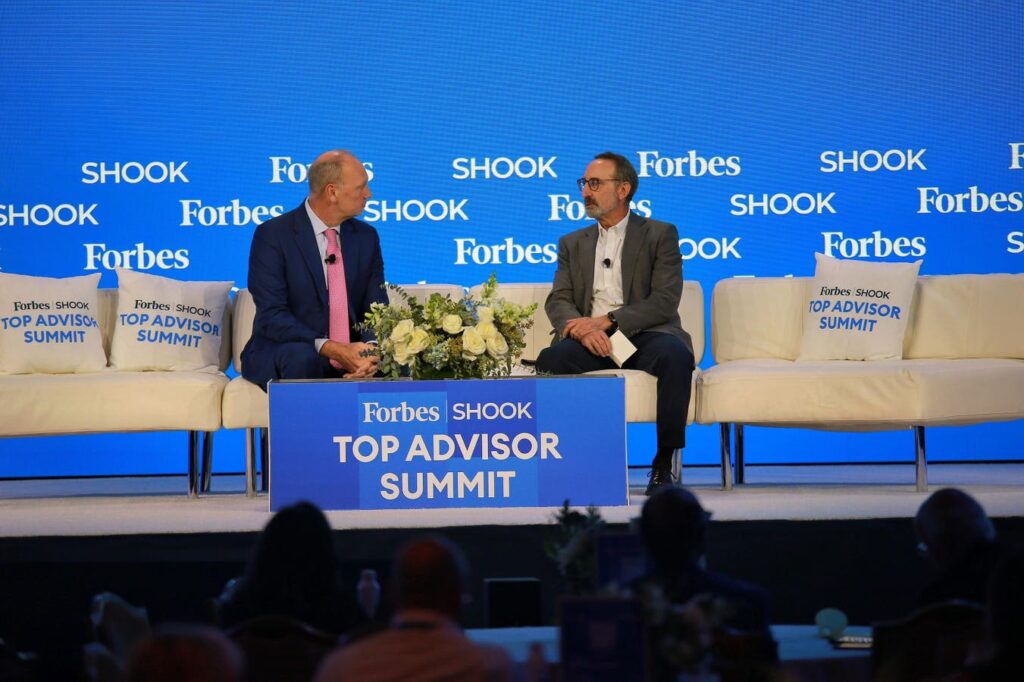State Street’s chief investment strategist, Michael Arone, says he’s still bullish on the market heading into 2026—just not comfortably so.
“I’m uncomfortably bullish,” Arone said last Thursday to a crowded room of wealth managers at the Forbes/SHOOK Top Advisor Summit at the Wynn Las Vegas. “We’re going to get stimulus from the One Big Beautiful Bill—with a big tax refund next season, more rate cuts from the Fed, and continued double-digit earnings growth,” he said. “That’s a powerful combination but the margin for error is small.”
With the S&P 500 hovering near record highs and trading around 26 times trailing earnings, Arone noted that analysts have actually raised profit estimates heading into third-quarter earnings. “That’s unusual, and it means the risk of disappointment is high,” he said.
The chief strategist at State Street, which just surpassed $5 trillion in assets under management, still believes the bullish case outweighs the risks: “The economy is cooling modestly, inflation is heading in the right direction and Fed policy is moving toward neutral.” Arone expects the Federal Reserve to cut rates at every meeting through year-end, with as many as two more cuts in 2026. “Policy has been too restrictive at 4.25% to 4.5%,” he said. “They’ve got room to ease without reigniting inflation.”
He identified two main risks to his outlook: the potential for a re-acceleration in inflation if growth and labor markets remain stronger than expected, and the danger that stretched valuations meet disappointing earnings. He’s less concerned about tariffs, which he said have been “a bit exaggerated” in terms of their economic impact. “The effective tariff rate could jump from 2.5% to 15%, and that might reaccelerate inflation somewhat—but so far, we’ve seen no major hit to GDP,” Arone said.
For this earnings season, he’ll be watching corporate outlooks more closely than quarterly beats. “Companies almost always beat the estimates… The real story is what executives say about the rest of this year and next,” Arone said. “Given the uncertainty, I expect those outlooks will be cautious.”
State Street remains overweight equities and real assets, underweight bonds, and holding little cash. Arone still sees stocks as a reliable inflation hedge but says investors need to broaden beyond megacaps. “We’re encouraging clients to diversify—into small caps, international equities, and equal-weighted tech exposure,” he said. “That way you still participate in AI and innovation, but you’re not doubling down on the same names.” He added that small-cap stocks, meanwhile, are seeing a “triple benefit” from lower rates, fiscal stimulus, and the potential end of quantitative tightening.
Arone also continues to emphasize “real assets”—a basket that includes gold, commodities, natural resources, real estate, and infrastructure—as an inflation and rate-volatility hedge. “Just owning gold isn’t a complete inflation hedge,” he said. “We think investors should have 10% to 15% of their portfolios in a diversified mix of real assets.”
He frames it as a modernized version of the traditional 60/40 portfolio: “Maybe it’s time to think 60/30/10,” he said, with that final 10% dedicated to tangible assets. “Commodities and natural resources have led, but lower borrowing costs could revive interest in real estate and infrastructure.”
Arone described the Fed’s current dilemma as “a dual mandate in tension.” Inflation remains above target, but the labor market is resilient and political pressure to cut rates is mounting. “They’re in a difficult spot, but they’ve done a reasonable job,” he said.
Despite Washington gridlock, Arone downplayed the latest government shutdown. “In 11 of the last 12 shutdowns, the economy expanded afterward, and the S&P 500 rose five out of five times,” he said. “This one looks a lot like 2013, when the market dipped 4% and then recovered quickly.”
Longer term, he sees the ballooning federal deficit as a structural headwind that will keep rates elevated and volatility higher. “Interest payments are going to keep rising and crowd out growth,” he said. “I’m not suggesting we’re going back to the 1970s, but we’re certainly not going back to the quantitative easing era of 2008 to 2022.”
Still, he believes stocks will hold up as long as the economy expands and earnings grow: “They are still a great long-term inflation hedge.”
Read the full article here

